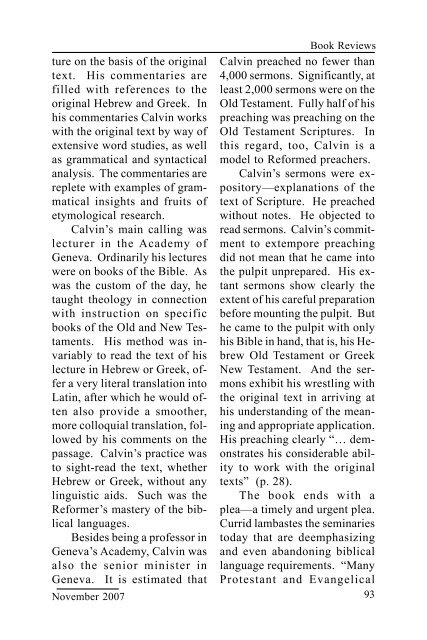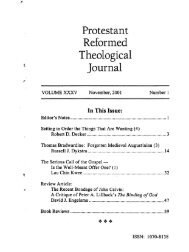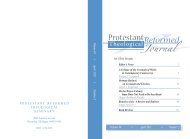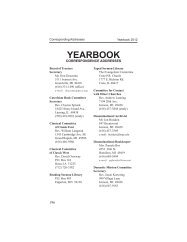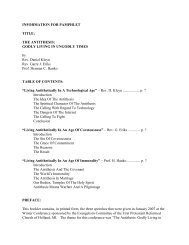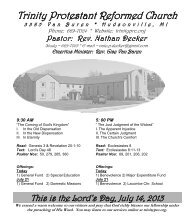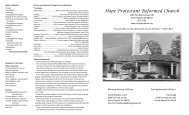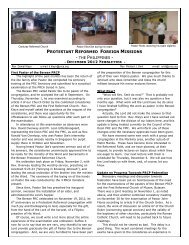November 2007 - Protestant Reformed Churches in America
November 2007 - Protestant Reformed Churches in America
November 2007 - Protestant Reformed Churches in America
Create successful ePaper yourself
Turn your PDF publications into a flip-book with our unique Google optimized e-Paper software.
Book Reviews<br />
ture on the basis of the orig<strong>in</strong>al Calv<strong>in</strong> preached no fewer than<br />
text. His commentaries are 4,000 sermons. Significantly, at<br />
filled with references to the least 2,000 sermons were on the<br />
orig<strong>in</strong>al Hebrew and Greek. In Old Testament. Fully half of his<br />
his commentaries Calv<strong>in</strong> works preach<strong>in</strong>g was preach<strong>in</strong>g on the<br />
with the orig<strong>in</strong>al text by way of Old Testament Scriptures. In<br />
extensive word studies, as well this regard, too, Calv<strong>in</strong> is a<br />
as grammatical and syntactical model to <strong>Reformed</strong> preachers.<br />
analysis. The commentaries are Calv<strong>in</strong>’s sermons were expository—explanations<br />
of the<br />
replete with examples of grammatical<br />
<strong>in</strong>sights and fruits of text of Scripture. He preached<br />
etymological research. without notes. He objected to<br />
Calv<strong>in</strong>’s ma<strong>in</strong> call<strong>in</strong>g was read sermons. Calv<strong>in</strong>’s commitment<br />
to extempore preach<strong>in</strong>g<br />
lecturer <strong>in</strong> the Academy of<br />
Geneva. Ord<strong>in</strong>arily his lectures did not mean that he came <strong>in</strong>to<br />
were on books of the Bible. As the pulpit unprepared. His extant<br />
sermons show clearly the<br />
was the custom of the day, he<br />
taught theology <strong>in</strong> connection extent of his careful preparation<br />
with <strong>in</strong>struction on specific before mount<strong>in</strong>g the pulpit. But<br />
books of the Old and New Testaments.<br />
His method was <strong>in</strong>-<br />
his Bible <strong>in</strong> hand, that is, his He-<br />
he came to the pulpit with only<br />
variably to read the text of his brew Old Testament or Greek<br />
lecture <strong>in</strong> Hebrew or Greek, offer<br />
a very literal translation <strong>in</strong>to mons exhibit his wrestl<strong>in</strong>g with<br />
New Testament. And the ser-<br />
Lat<strong>in</strong>, after which he would often<br />
also provide a smoother, his understand<strong>in</strong>g of the mean-<br />
the orig<strong>in</strong>al text <strong>in</strong> arriv<strong>in</strong>g at<br />
more colloquial translation, followed<br />
by his comments on the His preach<strong>in</strong>g clearly “… dem<strong>in</strong>g<br />
and appropriate application.<br />
passage. Calv<strong>in</strong>’s practice was onstrates his considerable ability<br />
to work with the orig<strong>in</strong>al<br />
to sight-read the text, whether<br />
Hebrew or Greek, without any texts” (p. 28).<br />
l<strong>in</strong>guistic aids. Such was the The book ends with a<br />
Reformer’s mastery of the biblical<br />
languages.<br />
Currid lambastes the sem<strong>in</strong>aries<br />
plea—a timely and urgent plea.<br />
Besides be<strong>in</strong>g a professor <strong>in</strong> today that are deemphasiz<strong>in</strong>g<br />
Geneva’s Academy, Calv<strong>in</strong> was and even abandon<strong>in</strong>g biblical<br />
also the senior m<strong>in</strong>ister <strong>in</strong> language requirements. “Many<br />
Geneva. It is estimated that <strong>Protestant</strong> and Evangelical<br />
<strong>November</strong> <strong>2007</strong> 93


